Winter is a challenging time for backyard birds such as cardinals, woodpeckers, nuthatches, chickadees, titmice and wrens.
But roosting in tree cavities, bird boxes and an assortment of makeshift shelters can help these birds stay warmer at night and give them an energetic edge.
Finding a snug place to sleep on a cold winter’s night is particularly important to Carolina wrens. They belong to a primarily tropical genus of wrens and seem to have limited capacity to deal with really cold weather and snow.
Carolina and other wren species nest in natural places such as upturned roots, tree stumps, vine tangles and tree cavities, but they also nest in a whimsical array of human artifacts. Roost sites and nest sites are often one and the same.
Birds of North America cites some favored nesting spots of the wren:
- Glove compartments of abandoned cars and inside garages.
- Old shoes and shelves.
- Mailboxes and tin cans.
- And an equally whimsical array of settings are listed as the wren’s roosting places:
- Bird nesting boxes and abandoned hornet’s nests.
- An old coat pocket and a hanging fern.
- Garages and barns.
- Squirrel nests and old bird nests.
- And at least one ceramic pig planter.
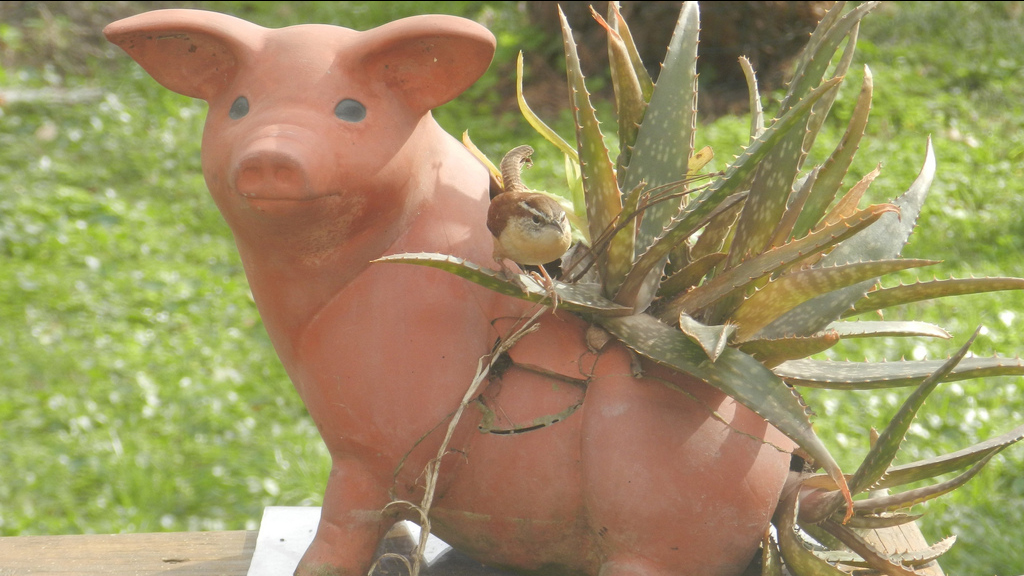
It seems that any place that can support a messy domed nest of twigs leaves, root fibers and moss is fair game for a wren.
I can add retractable awnings to the list. Every year, a pair of Carolina wrens builds its nest in an awning over my back deck – despite the mechanical activity of the awning and all the commotion below it. And in winter the pair uses the nest for roosting as well, particularly when the temperatures are below freezing.
I can be reasonably certain these are the same wrens in summer and winter because Carolina wrens don’t migrate, and pairs stay on the same territory throughout the year.
It’s been documented that the northern boundary of their range ebbs south and flows northward depending on how cold or mild the winters are over a series of years. When sustained below-zero temperatures and snow descend on the landscape, the wrens simply perish.
Near the northern edge of their range, there are clear benefits of backyard bird feeding to Carolina wrens. A study in Michigan found that bird feeding may even be supporting their northward expansion.
The research showed that in winter, wrens disappeared from areas with no bird feeders and remained common in areas that had bird feeders. It isn’t necessarily temperature that is driving wrens southward when the snow falls. It is their inability to find food during snowy conditions.
During the day, birds must eat enough to build up the fat reserves needed to keep them alive through long and cold winter nights.
Roosting in protected places gives the wrens (and other birds) a better chance of weathering the elements and conserving the hard-won energy reserves they gained during the day.
Studies of birds roosting in nests have shown that such domiciles confer critical energy savings. The same goes for roosting in tree cavities and bird boxes.
It’s not just wrens that are availing themselves of shelter when it gets cold. Woodpeckers and nuthatches nearly always use cavities to roost regardless of the weather, but chickadees and titmice resort to using cavities most often when it is very cold.
A study of the benefits of roosting in tree cavities on a cold night found that not all cavities are equal in their comfort levels. The bottom line of the research: cavities in bigger trees that are alive (not dead) hold the heat of the day longer and stay warmer at night.
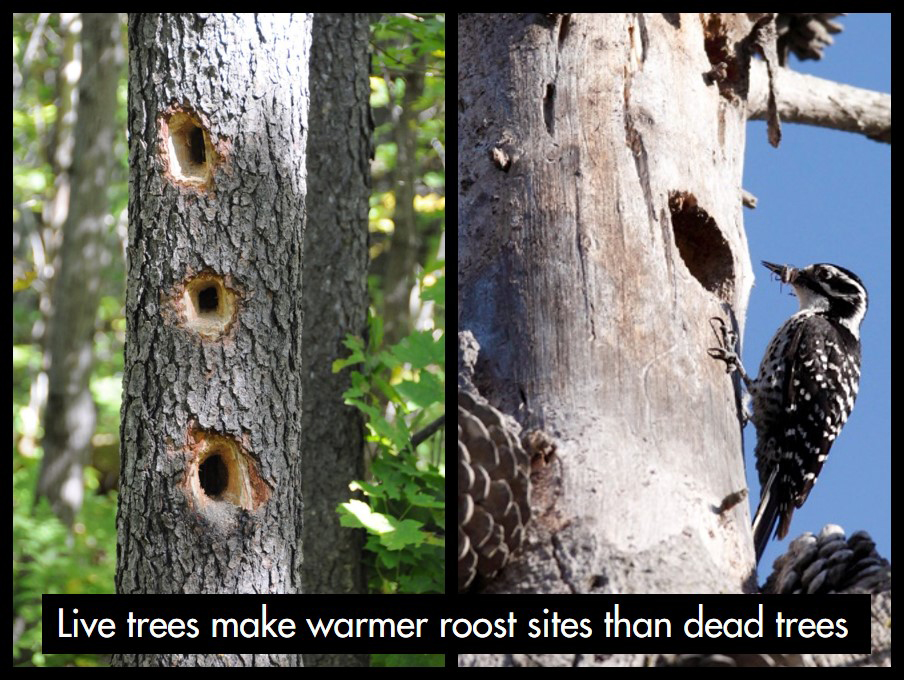
In the coldest times, some species will huddle together to stay warm. In his book Birds Asleep, Alexander Skutch shares this report on the tendency of winter wrens to huddle together on cold nights:
Nine slept in an old nest of a thrush,
Ten squeezed into a coconut shell and
Forty-six into a nesting box.
One observer noted over one hundred pygmy nuthatches entering the same dead pine trunk on a cold night. Bluebirds also roost communally in tree cavities and nesting boxes during frigid spells.
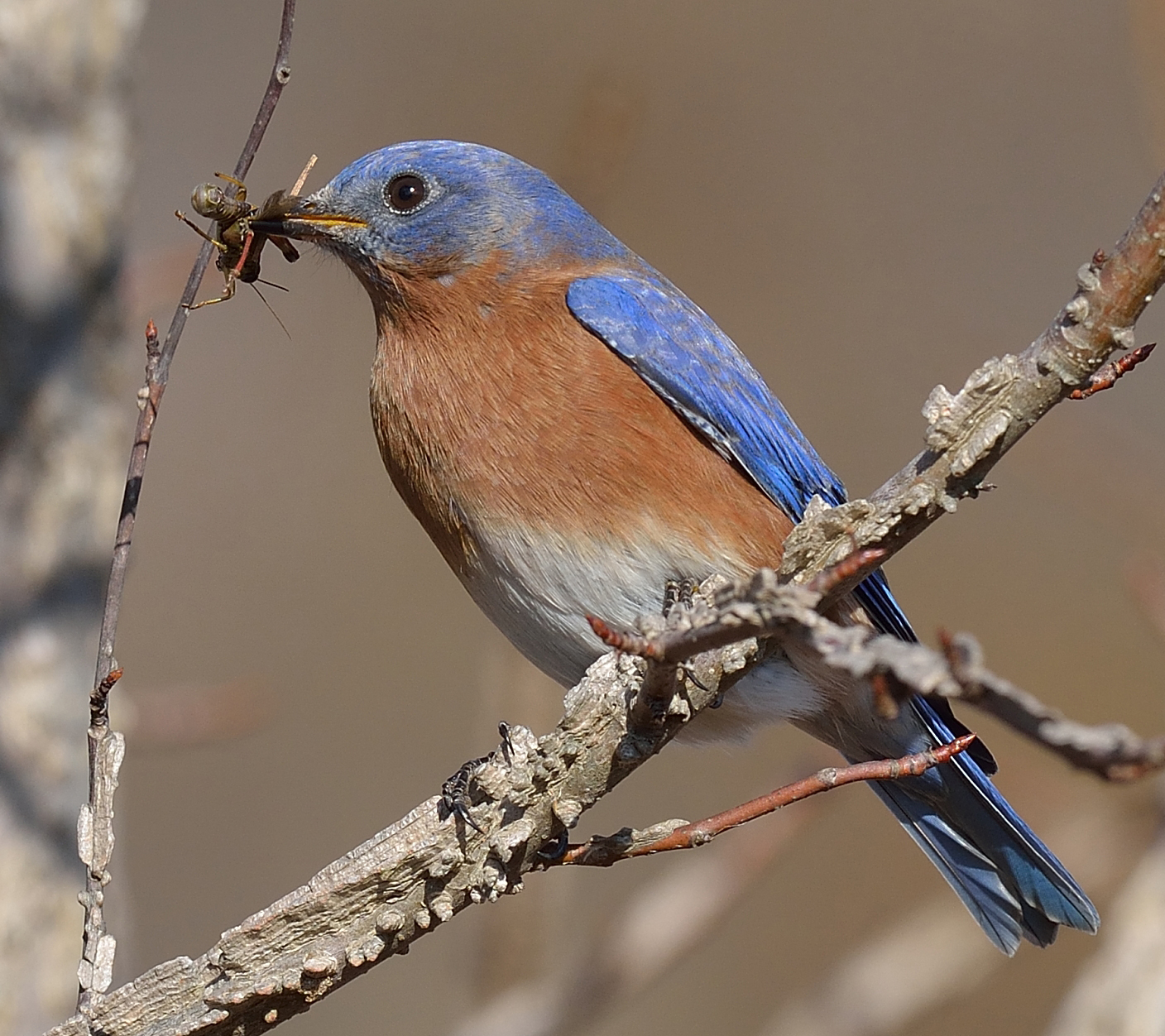
In milder weather, these same species tend to roost alone or in family groups. One individual winter wren was observed alternating between roosting alone and with other birds as the temperature oscillated from mild to frigid.
While our backyard birds might be just fine on their own, we can help birds by offering places for them to roost in winter. The easiest way to do this is to have a variety of bird boxes available during winter. If you are really creative, you can try to expand the list of wacky places where wrens will nest and roost. Poke around your yard for potential roost sites and watch and listen for birds going to roost just after sunset on winter days.
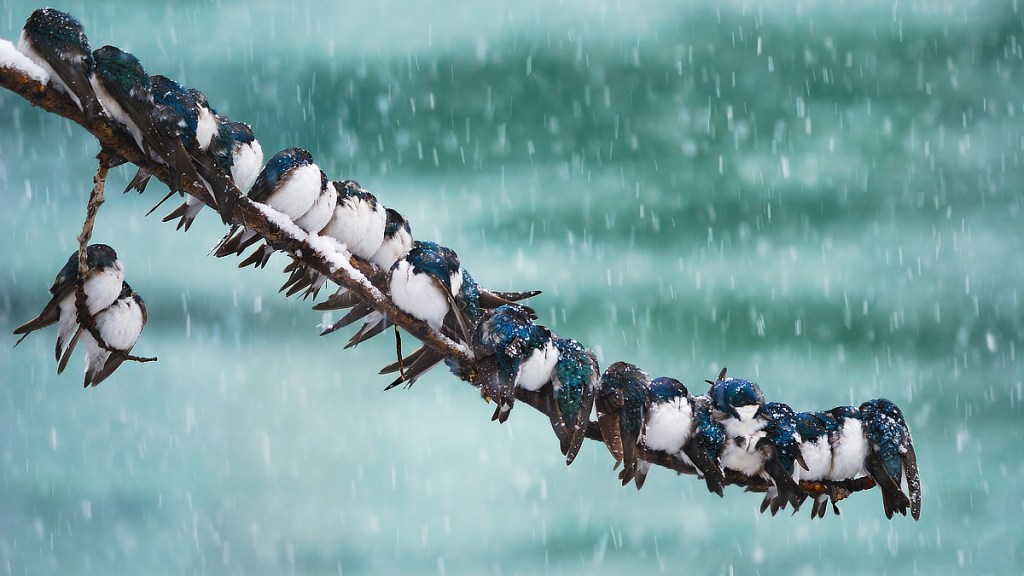
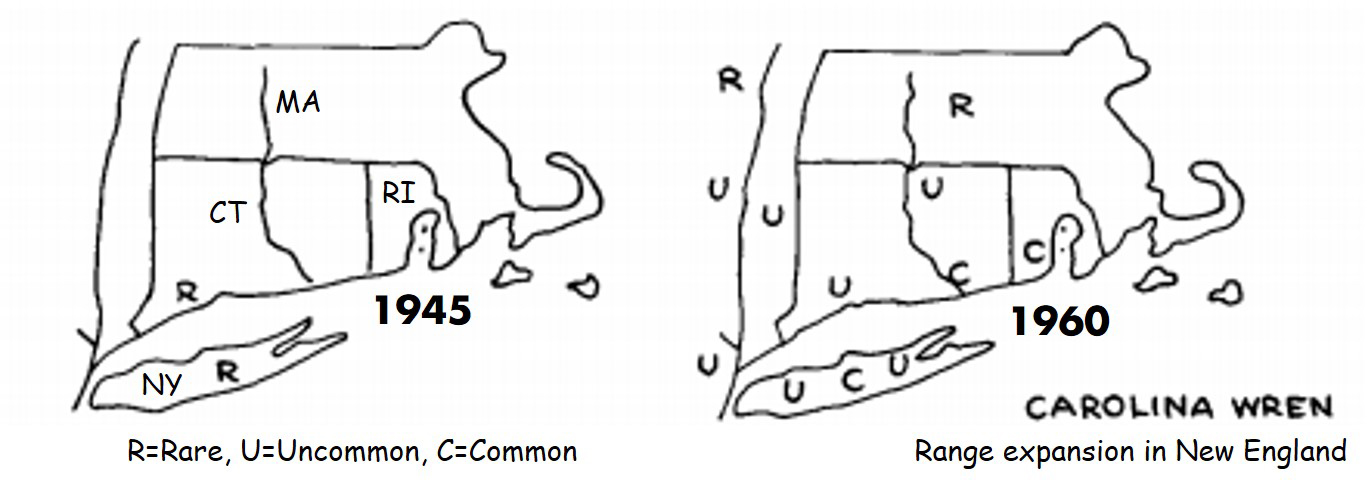
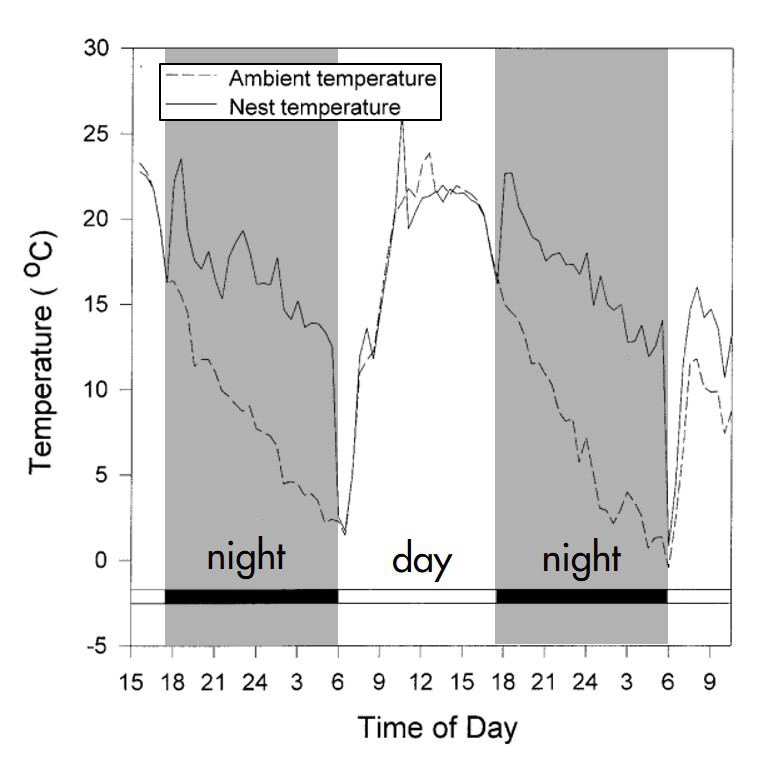



my young bird doesn’t fly or sing when the house is cold. i would like to know should i keep a warm house. also i smoke everything sometimes i think my bird gets a buzz. can anybody tell me what is up. i let my bird fly freely around my apt. he omnly uses the bathroom on paper. i think he has respect. he also comes and sits by me and sleeps where i sleep. i think my bird is smart and cool. tell how do i know if he is happy
Thank you for this article. I’ve had bird boxes in my garden for years, but have never seen a bird avail
itself of the shelter. Am I doing something wrong? Placement maybe? Zetta
Thank you for this article. I feed the birds and squirrels and many animals that come at night. It is really cold here in southeast Virginia tonight and I was worried about two Carolina wrens that sleep inside the folds of my largest patio umbrella. I usually put it away in winter but not this year! I have it pushed against my screened back porch behind a brick wall of the house. It keeps them sheltered from the wind and rain. They tuck themselves in every night at the same time. As it started getting darker earlier each night they started to come a little earlier, just like “clockwork.” I wondered if I should put some hay in there somehow but I’m concerned I will scare them off, even though they are bold, little birds… I just adore them!
Hi, I have a pair of Carolina wrens that have 5 eggs in a small nest just outside our side door under a porch, it’s April 1st, in the next week Charlotte temperatures are suppose to be possibly freezing at night for a few nights,is there anything we can do to help keep the eggs & wrens warm, or should we let them be & hope for the best? Thanks Thomas
I had a Carolina wren who built a nest in the engine of my tractor and stayed there all winter. My parents live in Indiana, and they have a terra cotta wallhanging in the shape of a face, and the wrens have built nests in the nostrils of it! They are very adaptable ;-).
this answered some of the questions ive had on where birds go at night
After the holidays I take my tree outside, stake it so the wind doesnt blow it over & decorate it with bird treats, suet, berries,etc . The birds love it!
As we saw snow fall for over 24 hrs in the past 2 days, i noticed that many birds had burrowed through the snow on the tree to make little “igloos” where they roosted, apparently keeping warm & protected from the extreme temps. A variety of birds including juncos, finches, sparrows & titmouses continued to stay in the tree even after the little white lights came on. They usually roost in a tall privet hedge along the house, but perhaps they liked having an extra bit of warmth from the lights?
“there are clear benefits of backyard bird feeding to Carolina wrens. ” What are you feeding them? They’ll take meal worms, but as far as I know, that’s about it. They eat bugs, not seed, right?
I always worry about wild animals and esp the birds around here during cold spells. the fall was so mild, I observed many wrens still in the yard or at least heard them. now all of a sudden it is cold and ground is covered with snow. were they ” tricked ” into staying around? how do the wrens survive here. I have never seen one eating from the seed we put out. do they only eat insects? what about berries? is there anything we can do to help them survive? lucky we have 2 abandoned sheds with several openings for birds to find shelter maybe. we live in southern n.j. , one mile from the bottom of the turnpike. thank you, I enjoy your writings, f
Out buildings that are unused could have small openings let into them as possible shelters for wild birds. Clean ice free water needs to be provided, and well stocked feeders with a variety of different fresh foods need to be supplied, above ground and away from potential predators. Cat owners should keep their house cats indoors; house cats are aggressive predators of wild birds, they can themselves be attacked by larger wild predators. There are any number of winter shelters that can be home made and placed in predator safe locations to aid wild birds over winter.
Add Christmas wreath to your list for Carolina Wren. I usually have to leave mine up as she spends the winter in it and then builds a nest in the spring.
I have a large patch of Bamboo in my backyard and literally hundreds of small birds roost there every night. The thickness of the bamboo provides warm and safe shelter. I love hearing their 10 min long chatter (seems like they all talk at once) at dusk and dawn. Happy to have them as co-residents in my yard.
Great idea. Thank you!
For an accessible book with fascinating insights into how animals, including birds, survive winter, check out Bernd Heinrich’s book “Winter World: the ingenuity of animal survival.”
My father was an ornithologist and banded birds while I was a child. I would go with him to check the traps and mist net and watch him gently examine each bird, document and band them. Over the past 50 years, I have watched their sustaining habitat, here in Ohio, diminish into very small patches. The awareness factor of wildlife has been diminished along with the “born” responsibility as an American to care for our land. We use to see PSA’s on TV that would jar our conscience, but they too are a thing of the past. We were taught Respect for all living things…and if you could help the bees, critters, animals…you did so. It was a united – “given” in our society. God, help us….before they are all gone.
I’m with you. Thank you.
I live about 15 miles north of Bennett, CO. I have been finding dead finches in my yard. The temps here have been below 32 degrees at night and we have had some high 40’s during the day and there is still snow on the ground. It breaks my heart to see these poor birds like this! We live out on the plains.
Is there some way I can give them more shelter? I have friends who “donated” their Christmas trees so they can get some more shelter. Would bales of hay help?
I do feed them daily. Any suggestions would be welcomed!